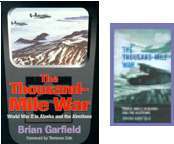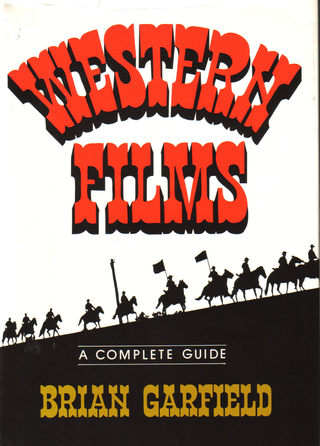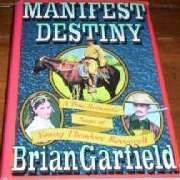By Brian Garfield
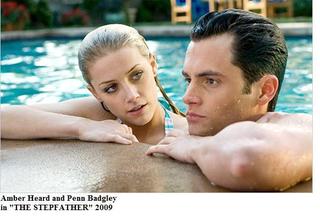
THE STEPFATHER
A recent film version (remake) of the 1987 Brian Garfield-Donald E. Westlake movie "The Stepfather" went into wide release in 2009, and is now available on DVD.
HOPSCOTCH
DEATH WISH
THE MEINERTZHAGEN MYSTERY
It was a fraud. His reputation is based on his own stories. The great adventures are tall tales -- it turns out they have little or no basis in fact.
Brian Garfield's new biography, substantially based on formerly sealed and recently released records as well as extensive interviews with RM's family and those who knew him, separates the heroics from the hoaxes.
It is an astonishing story, and a great read.
-----
For those who have some knowledge of Richard Meinertzhagen and would like to know more about his activities in Africa than is included in "The Meinertzhagen Mystery", the texts of unpublished passages by Brian Garfield (including sources and notes) can be obtained on request by email from Gerald Rilling at eafricabk@ix.netcom.com .
. . . . For the Wall Street Journal's review of "The Meinertzhagen Mystery", see "Events" page (tab at top of this page).
Movies
DEATH WISH. The movie remake will be produced by Sony in 2012 for MGM, starring and directed by Sylvester Stallone, for release in 2013. The original was filmed in 1974, with Charles Bronson, Hope Lange and Vincent Gardenia. That movie introduced actors Jeff Goldblum and Olympia Dukakis, among others. Sequels “Death Wish II - III - IV - V” were filmed in the 1980s and 1990s. Garfield did not write, and did not care for, the sequels. His own sequel novel was filmed in 2007 (see "Death Sentence" below).
HOPSCOTCH. Garfield's book won the Mystery Writers of America's Edgar Allan Poe Award (the Edgar) as best novel of the year. Garfield co-produced the movie. The screenplay co-written by Garfield was a nominee-finalist for the Writers Guild of America Award. Filmed in 1980 with Walter Matthau, Glenda Jackson, Sam Waterston, Ned Beatty and Herbert Lom; directed by Ronald Neame. The author’s company, Shan Productions, co-released the film. A DVD, including both the theatrical version and the unrated Director's cut -- and on-camera interviews with Garfield and Neame -- is available from The Criterion Collection. Brian feels this is by far the best movie made from his work (to date, at least) and adds, "It's fun for audiences, and we had great fun making it. What more can one ask?"
DEATH SENTENCE. 2007 release, starring Kevin Bacon, Kelly Preston, John Goodman, Garrett Hedlund and Aisha Tyler; directed by James Wan. (20th Century-Fox.) Now available on DVD, with numerous extras including the theatrical version and the unrated full-length director's cut. Garfield (uncredited) wrote the first drafts of the screenplay, and the shooting script by Ian Mackenzie Jeffers is faithful (at last) to the theme of the original. It's an excellently directed action movie, and it makes the point it was intended to make, both by the filmmakers and by Brian, whose main caveat is his wish that director James Wan might have made a better film if he'd muted his enthusiasm for gory violence.
WILD TIMES. Nominee for an American Book Award. Filmed as a television mini-series, 1980, with Sam Elliott, Ben Johnson, Penny Peyser, Pat Hingle, Dennis Hopper, L.Q. Jones, Gene Evans, Harry Carey Jr. and many others. The film now belongs to 20th Century-Fox Home Entertainment; it is exhibited on cable TV channels.
THE STEPFATHER. Movie based on Donald E. Westlake’s screenplay from an original story by Brian Garfield -- 1987, with Terry O'Quinn (a stunning performance), Shelley Hack and Jill Schoelen (whose work in the film won an award in a European film festival); directed by Joseph Ruben. Garfield's company, Shan Productions, co-released the film, which won festival awards and has become a cult favorite.
The 2009 DVD of this film includes segments of an interview with Garfield about the film.
Sequels "Stepfather II" and "III" appeared subsequently.
Sony/Screen Gems released a remake of the movie in the fall of 2009, with a cast that includes Dylan Walsh, Penn Badgley, Sela Ward and Amber Heard (who is excellent); director is Nelson McCormick.
THE LAST HARD MEN. Western suspense-adventure, set in 1911 and filmed in 1976 on location on Garfield's home territory of Southern Arizona, with stars Charlton Heston, James Coburn, Barbara Hershey, Michael Parks, Christopher Mitchum; directed by Andrew V. McLaglen. It is based on Garfield's novel, and he worked as (uncredited) on-location script doctor.
RELENTLESS. Filmed for CBS TV in 1977 with Will Sampson, Marianna Hill, John Hillerman, Monte Markham. Screenplay was by Sam Rolfe, a good friend with whom Brian Garfield worked several times. This appears to have been the first major-company movie in which a Native American hero was portrayed by a top-billed Native American actor.
NECESSITY. Filmed for CBS TV in 1989, with Loni Anderson, John Heard, James Naughton. Garfield was on location with this suspense thriller, which is based on his novel.
FLESHBURN. Based on Brian Garfield’s suspense novel Fear in a Handful of Dust, originally published over the pen-name John Ives, the 1984 film starred Steve Kanaly, Karen Carlson and Sonny Landham; it was co-produced and directed by George Gage, and co-produced by Ashok Amritraj (who also co-produced the recent "Death Sentence").
LEGS. TV-movie based on original screen story and script by Brian Garfield, 1983. The ABC telefilm, with Gwen Verdon, John Heard, Sheree North, is Garfield's only (to date) musical -- it was co-produced by Radio City Music Hall and features the Rockettes.
SCRIMSHAW. Based on Brian Garfield’s short horror story, this half-hour television film was broadcast as part of Survival Anglia’s “Tales of the Unexpected” series. It starred Joan Hackett, Charles Kimbrough and John Houseman.
-o-o-o-
TV and movies in the chute --
MANIFEST DESTINY: A True Romantic Saga of Young Theodore Roosevelt. Long-form television miniseries based on Brian’s historical novel about TR’s adventures in the Dakota Badlands. It is being prepared for release in 2013.
DEATH WISH -- Sylvester Stallone's remake for MGM is tentatively scheduled for release in 2013.
A movie based on "The Meinertzhagen Mystery" and a remake of "Hopscotch" are in the development hopper.
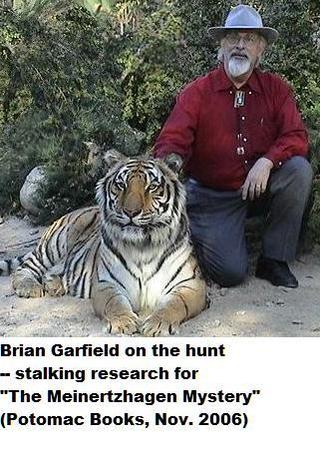
WRITING SUSPENSE FICTION
by Brian Garfield
(Beneath this article is a list of Garfield's works.)
These "rules" for writing suspense fiction were published in WRITER'S DIGEST, Feb. 1973, and reprinted in the 1994 WRITER'S YEARBOOK, pp 22-23:
Brian Garfield has reviewed the article and feels it is still valid because the principles it describes have not changed.
<< THE English call them thrillers, and in our clumsier way we call them novels of suspense.
They contain elements of mystery, romance and adventure, but they don’t fall into restrictive categories. And they’re not circumscribed by artificial systems of rules like those that govern the whodunit or the gothic romance.
The field is wide enough to include Alistair MacLean, Allen Drury, Helen Maclnnes, Robert Crichton, Graham Greene and Donald E. Westlake. (Now there’s a parlay.) The market is not limited by the stigmata of genre labels, and therefore the potential for success of a novel in this field is unrestricted: Day of the Jackal, for instance, was a first novel.
Game’s object: to perch the reader on edge -- to keep him flipping pages to find out what’s going to happen next.
The game’s rules are harder to define; they are few, and these are elastic. The seasoned professional learns the rules mainly in order to know how to break them to good effect.
But such as they are, the rules can be defined as follows.
**Start with action; explain it later.
This is an extension of Raymond Chandler’s famous dictum: When things slow down, bring in a man with a gun. To encourage the reader to turn to page 2, give him something on page 1: conflict, trouble, fear, violence. I realize you’ve got a lot of background that needs to be established, leading up to the first moments of overt conflict, but you can establish all that in chapter 2. Flash back to it if you need to. But in chapter 1, get the show on the road.
**Make it tough for your protagonist.
Give him a worthy antagonist and make things look hopeless. Don’t drop convenient solutions in his lap. The tougher the opposition, the more everything is stacked against the protagonist, the better.
**Plant it early, pay it off later.
Don’t bring in new characters or facts at the end to help solve the protagonist’s dilemma. He must work out his own solution based on a conflict that’s established early in the story. No cavalry to the rescue, and no sudden unearthing of a revealing letter written before he died by a character who was dispatched way back in chapter 3. (Unless, of course, you established in chapter 4 that such a letter exists, and followed that revelation with a race between the protagonist and his enemies to see who’ll get the letter first.) No cavalry to the rescue.
**Give the protagonist the initiative.
All good dramatic writing centers on conflict: interior (alcoholism, oedipal conflicts) or exterior (a dangerous enemy, an alien secret police force). Only in poor gothic fiction is the protagonist habitually and tearfully and hand-wringingly at the mercy of evil opposing forces that push him or her around at will. The best story is usually that in which the protagonist takes active steps to achieve a goal against impossible odds, or to prevent opposing forces from overcoming him or his loved ones. The protagonist may begin by reacting, but in the end he must act from his own initiative.
**Give the protagonist a personal stake.
No longer is it acceptable for the hero to solve a mystery just because it presents an interesting puzzle. The more intimate his involvement in the main conflict of the story, the better. He himself, or his aims, should be in jeopardy: His own life or those of his loved ones should be in danger, or his best friend has been murdered, or he is the kind of character whose values and principles won’t let him sit by and allow injustice to destroy people around him. Whatever the conflict is, if he loses, it’s going to cost him horribly; that’s the essence.
**Give the protagonist a tight time limit, and then shorten it.
This doesn’t always work because the logic of many stories prohibits it; don’t use it unless you can work it in believably. But when time is a factor, and when the brief span of time in which the hero must resolve the conflict is then shortened, you have gone a long way toward heightening the suspense.
**Choose your character according to your own capacities, as well as his.
Don’t use as your protagonist an accomplished professional spy unless you are prepared to do the research and groundwork necessary to create such a character convincingly. It is better, particularly when approaching the early stages of your own professionalism, to stick to the familiar. Some of the most successful suspense-novel protagonists — many of Eric Ambler’s, for instance — are ordinary innocent people caught up in dangerous webs. The indignant honest idealist makes a good protagonist because his innocence makes the professional opposition all the more frightening. Yet a plot-structure for this character is often difficult to contrive because, in spite of his naiveté, he has to be clever and resourceful enough (not lucky) to prevail over his awesome enemies. The other face of this coin, of course, is the professional-crook-as-protagonist; he’s easy to identify with because he’s an outcast, an underdog, one man using his wits to survive against society’s oppressive machinery. But the pitfalls of this genre are treacherous, and unless you know criminal procedure and feel comfortable competing with Anthony Burgess and Richard Stark, it’s better to avoid the crook-hero in the beginning.
**Know your destination before you set out.
The prevailing weakness of many suspense stories that are otherwise successful is the letdown the reader experiences at the end: the illogical and disappointing anticlimax. It isn’t enough to set up intriguing conflicts and obey all the other rules if you haven’t got an ending that fulfills the promise of the preceding chapters. It becomes disgustingly obvious when a writer has confronted his hero with thrilling obstacles only to paint himself into a corner. Presented with his own unsolvable cliffhanger, he is reduced to bringing in deus ex machina to solve the hero’s problems for him. It isn’t necessary to tie up all loose ends, but the climax should resolve the principal conflict one way or another. (In recent years, to avoid the traditional clichés of virtue-triumphant or ironic-downfall, several talented novelists have resorted to obscure endings that no reader could possibly decipher. I rather hope the fad is dying out; whatever the reasons behind it, it demonstrates lazy thinking and infuriates the reader.) The best key to a good ending is to know what the ending will be
before you start writing the book. Whether you write a preliminary outline or not, you should know where the journey will end, and how.
**Don’t rush in where angels fear to tread.
I admit this one is a catchall. Essentially I mean that it is wise to observe not only what the pros do, but also what they avoid doing. The best writers do not jump on bandwagons; they build new ones. The pro doesn’t write a caper novel about the world’s biggest heist unless he’s convinced he can write an unusual story with a unique and important twist. Otherwise he risks unfavorable comparison with the classics in that subgenre. “Why bother with it if it’s not as taut as Rififi and not as funny as The Hot Rock?” Yet this should not be taken to mean every writer must obey faddish advice, such as “Spy fiction is dead,” or “Historical novels are out this season.” There is no such thing as a dead genre because the human imagination is limitless, and there is never a dearth of new ideas, new twists, new talents. The question is, “Is this idea strong enough and important enough to make the story sufficiently different from its predecessors to merit publication?” If a novel is good enough, it will find a publisher whether it is a hard-boiled detective story, a western, a spy novel, a historical adventure, or a novel about bug-eyed monsters from Mars. If it isn’t good enough, the publisher may reject it by saying that such novels are out of style, but this is merely a euphemism.
**Don’t write anything you wouldn’t want to read.
This one sounds self-evident, but I’ve met several young writers who decided they wanted to start out by hacking their way through gothics or westerns, just to learn the ropes, because those categories looked easy to imitate. Nuts. If you start out that way, you’ll end up a hack. Now if you like to read westerns, then write a western. But don’t write into a genre for which you have contempt. If you don’t like gothics but insist on writing one, your contempt will show; you can’t hide it. I don’t say you can’t sell books this way; God knows people do, all too often. But if you thoroughly enjoy sea stories — even if you don’t know a thing about nautical life — you’re better off attempting to write a sea story because you’ll go into it with enthusiasm, you’ll make it a point to learn the terminology and the life, and you’ll write a far better book.
Under various names, I wrote some 50 novels in order to learn the above precepts. This article is offered in the hope that one or two of my rules will help you. >>
Selected Works by Brian Garfield
CHECKPOINT CHARLIE. Collection of espionage short stories.
DEATH SENTENCE. Suspense novel. Filming in 2006 for 2007 release, starring Kevin Bacon, Kelly Preston, John Goodman and Aisha Tyler; directed by James Wan.
DEATH WISH. Suspense novel. Filmed in 1974, with Charles Bronson. Sequels filmed in the 1980s and 1990s.
DEEP COVER. Suspense novel.
FEAR IN A HANDFUL OF DUST. Suspense novel. (Pen-name: John Ives.) Filmed as FLESHBURN.
THE HIT and THE MARKSMAN. Duo - suspense novels.
HOPSCOTCH. Suspense novel. Winner of Mystery Writers of America's Edgar Allan Poe Award as best novel of the year. Filmed in 1980. Screenplay co-written by Garfield was a nominee-finalist for the Writers Guild of America Award. The author’s company, Shan Productions, co-released the film.
KOLCHAK'S GOLD. Suspense novel. Brian Garfield’s favorite among his own novels.
THE LAST HARD MEN. Western novel. Filmed in 1976 with Charlton Heston and James Coburn.
LEGS. TV-movie based on original screen story & script by BG. 1983, ABC, with Gwen Verdon, John Heard, Sheree North. Musical about the Radio City Rockettes.
LINE OF SUCCESSION. Suspense novel.
MANIFEST DESTINY: A True Romantic Saga of Young Theodore Roosevelt. Historical novel, being prepared for filming in 2007-2008.
NECESSITY. Suspense novel. Filmed for CBS TV in 1989, with Loni Anderson, John Heard.
THE PALADIN. Historical novel. By Brian Garfield in collaboration with "Christopher Creighton" (a pseudonym).
RECOIL. Suspense novel.
RELENTLESS. Suspense novel. Filmed for CBS TV in 1977 with Will Sampson, Marianna Hill, John Hillerman.
THE ROMANOV SUCCESSION. Suspense novel.
THE STEPFATHER. Movie based on original story by Brian Garfield -- 1987, with Terry O'Quinn, Shelley Hack. Garfield's company, Shan Productions, co-released the film. It spawned two sequels.
SUSPENDED SENTENCES - collection of short crime stories.
SWEENY'S HONOR. Historical novel.
THE THOUSAND-MILE WAR: World War II in Alaska and the Aleutians. Nonfiction book. Pulitzer Prize finalist in History, 1970. 2003-2008 bestselling title, University of Alaska Press.
THE THREEPERSONS HUNT. Suspense novel.
TRIPWIRE. Western suspense novel.
THE VANQUISHED. Historical novel.
THE VILLIERS TOUCH. Suspense novel.
WESTERN FILMS: A Complete Guide. Nonfiction book.
WHAT OF TERRY CONNISTON? Suspense novel.
WILD TIMES. Historical novel. Nominee for an American Book Award. Filmed as television mini-series, 1980, with Sam Elliott, Ben Johnson, Dennis Hopper, L.Q. Jones.
According to Newsweek Magazine, Brian Garfield's tips for suspense writing were the source of John Grisham's success. Garfield's article can be found above on this page. Other information about him can be found at the website below:
LINKS to information about Brian Garfield's movies (from the New York Times and elsewhere):
http://www.themysteryplace.com/ahmm/crime/
From reviews of books by Brian Garfield:
"Garfield is one of the best. Anyone settling down with a Garfield book is in for a good time." - The New York Times (1975, reviewing Hopscotch).
"A scintillating, talented writer." - Newsday (1972, reviewing Death Wish).
"Engrossing and exciting... I couldn't put it down." - Robert Ludlum (1977, commenting on Recoil).
"This might well be required reading. It's edge of the chair all the way. . . Wholly fascinating and thought-provoking." - Booklist (1974, reviewing Death Sentence).
THE THOUSAND-MILE WAR: World war II in Alaska and the Aleutians
WESTERN FILMS: A Complete Guide
In all, the book includes over 2,000 films. The more than 100 illustrations include rare publicity photos, movie stills of famous actors, and lobby posters. The complete bibliography will be handy for the serious student of film.
